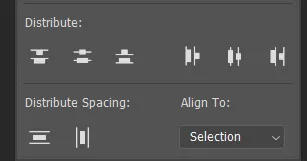How to align multiple images in Photoshop. Besides color correction, distance alignment is also extremely important and it is imperative that we master it to create quality photos. This is not a difficult technique because Photoshop already has this built-in function. In this article, Ngolongtech will introduce each alignment function so that you can understand and use them to suit your needs.

Table of Contents
Overview of Align in Photoshop
Before learning how to use Align in Photoshop, I will go through some cases where it can be applied to align objects in Ps.
- Used to align objects (layers) in Photoshop in the following dimensions: top, bottom, left, right, center, and distance.
- There are 2 main alignment groups in Photoshop including alignment options (Align) and alignment options (Distribute).
- You can use Align with 2 or more layers or groups in the same working file
- You can use Align with 2 modes including Selection (align to layer) and Canvas (align to page).
1. Use Align with the alignment option
Align in Photoshop supports you with 6 alignment options with objects. To do this, follow these 3 steps:
Step 1: Select the Selection tool and display the option instead
First in Photoshop you need to select the Selection tool (V). Then you check the software to make sure you have displayed the option option in Photoshop. If you don’t see the option, do it: from the menu bar -> Window -> Option
Step 2: Select the object to align in Photoshop
In Photoshop each object (color array) is managed by a separate layer or group. So when you want to align objects in the working file you need to select the layers containing the objects
- Here to be able to open the layer palette of your choice Menu -> Window -> Layers (F7). In case you already have the layers palette open, you don’t need to do this
- Now you need to select the layers that you want to align them with by holding down Ctrl + left clicking on each layer in the layer dialog box. Or on the option bar -> Auto select-> Then hold Shift + Click each object on the workspace
Step 3: Align the position of objects in Photoshop
After you select the layers to align, now on the Option change the Align alignment icons in Photoshop will light up and we have 6 corresponding alignment modes including:
- Align leftmost: Allows you to align all selected layers to the left of the furthest layer in the working file.
- Vertical Center: Allows you to center the entire selected layer vertically (Oy axis) and towards the center of the selected layer group
- Rightmost unit: Allows you to align all selected layers to the right of the furthest layer in the working file.
- Align Top: Allows you to align all selected layers to the top of the highest layer
- Center Horizontally: Allows you to center the entire selected layer horizontally (Ox axis) and towards the center of the selected layer group
- Bottom Align: Allows you to align all selected layers to the bottom of the lowest layer
2. Using Align with Distance Align Option
In Photoshop you can use Align to align the relative distance between objects. With new versions like Photoshop cc 2019, CC2020 we have 2 groups of distance alignment commands including: Distribute and Distribute Spacing. Performing alignment commands is similar to aligning objects in case 1. However, in new versions you will not see these options displayed right on the control bar. To find them click on the vertical ellipsis icon. Now the Align panel will appear, perform the following steps to align the distance:
Step 1: Select the objects to align
Similar to the case of aligning objects. The first thing you need to do is select the objects (layers) that you want to align. To be able to do this, do the following: From the layer dialog (F7) -> Select the layers containing the objects you want to align by holding Ctrl + Click on the layer.
Step 2. Select Align Style in Photoshop (New Version)
Now after you have selected the objects to be aligned at this time with old Photoshop versions from cc2018 and earlier, you will see the relative position alignment options appear on the Option bar. But with the latest versions of Photoshop you won’t see this option. Instead of the 3-dot icon>You click on this icon a dialog box appears->At the Align to section-> You choose Selection or Canvas-> Finally you choose for yourself a suitable alignment mode.

Step 3: Align the distance of the objects
In step 2 you have chosen to open the selection panel of alignment modes in Photoshop. Now we choose any property so that we can perform distance alignment with Align in Photoshop. Please note the following icons:
- Align the distance above: Align in Photoshop will align the distance of each object’s highest vertex to another’s highest vertex
- Center Horizontally: Align in Photoshop calculates the object’s center of gravity. It then evenly spreads the distance between the center of one object and the center of another. Horizontal of the working file of course (Ox axis)
- Bottom Spacing: Photoshop performs bottom positioning of each object. Then align the distance between the positions of one object to another
- Align distance to the left: Photoshop will determine the outermost point of each object in the working file. It will then align the distance from the outermost position of one object to another
- Vertical centering: Align in Photoshop performs calculations in the center of the object. It then evenly spreads the distance between the center of one object and the center of another. Vertically of the working file of course (Oy axis)
- Align the right spacing: Photoshop also determines the bottom position of each object. Then align the distance between the positions of one object to another
- Evenly Spacing Vertically : Allows to align the distance between selected objects to each other vertically
- Horizontal spacing : Align in Photoshop allows you to align the distance between selected objects horizontally

Align objects on different layers
You can align the content of layers and groups using the Move tool 
-
Do one of the following:
-
To align multiple layers, select the layers with the Move tool or in the Layers panel, or select a group.
-
To align the content of one or more layers to a selection border, make a selection in the image, and then select the layers in the Layers panel. Use this method to align to any specified point in the image.
-
-
Choose Layer > Align or Layer > Align Layers To Selection, and choose a command from the submenu. These same commands are available as Alignment buttons in the Move tool options bar.
Top Edges
Aligns the top pixel on the selected layers to the topmost pixel on all selected layers, or to the top edge of the selection border.
Vertical Centers
Aligns the vertical center pixel on each selected layers to the vertical center pixel of all the selected layers, or to the vertical center of the selection border.
Bottom Edges
Aligns the bottom pixel on the selected layers to the bottommost pixel on selected layers, or to the bottom edge of the selection border.
Left Edges
Aligns the left pixel on the selected layers to the left pixel on the leftmost layer, or to the left edge of the selection border.
Horizontal Centers
Aligns the horizontal center pixel on the selected layers to the horizontal center pixel of all the selected layers, or to the horizontal center of the selection border.
Right Edges
Aligns the right pixel on the linked layers to the rightmost pixel on all selected layers, or to the right edge of the selection border.
Distribute layers and groups evenly
Updated in the October 2018 release of Photoshop CC (version 20.0)
-
Select three or more layers.
-
Choose Layer > Distribute and choose a command. Alternatively, select the Move tool
 and click a distribution button in the options bar.
and click a distribution button in the options bar.Top Edges
Spaces the layers evenly, starting from the top pixel of each layer.
Vertical Centers
Spaces the layers evenly, starting from the vertical center pixel of each layer.
Bottom Edges
Spaces the layers evenly, starting from the bottom pixel of each layer.
Left Edges
Spaces the layers evenly, starting from the left pixel of each layer.
Horizontal Centers
Spaces the layers evenly, starting from the horizontal center of each layer.
Right Edges
Spaces the layers evenly, starting from the right pixel on each layer.
Horizontally
Distributes horizontal spacing between the layers evenly.
Vertically
Distributes vertical spacing between the layers evenly.
Automatically align image layers
The Auto-Align Layers command can automatically align layers based on similar content in different layers, such as corners and edges. You assign one layer as a reference layer, or let Photoshop automatically choose the reference layer. Other layers are aligned to the reference layer so that matching content overlays itself.
Using the Auto-Align Layers command, you can combine images in several ways:
-
Replace or delete parts of images that have the same background. After aligning the images, use masking or blending effects to combine parts of each image into one image.
-
Stitch images together that share overlapping content.
-
For video frames shot against a static background, you can convert frames into layers, then add or delete content across multiple frames.
-
Copy or place the images you want to align into the same document.
Each image will be in a separate layer. See Duplicate layers.
Note:You can load multiple images into layers using a script. Choose File > Scripts > Load Files into Stack.
-
(Optional) In the Layers panel, create a reference layer by locking it. See Lock layers. If you do not set a reference layer, Photoshop will analyze all the layers and select the one at the center of the final composition as the reference.
-
Select the remaining layers you want to align.
To select multiple adjacent layers from the panel, Shift-click; To select noncontiguous layers, Ctrl-Click (Windows) or Command-click (Mac OS).
Note:Do not select adjustment layers, vector layers, or Smart Objects that do not contain information needed for alignment.
-
Choose Edit > Auto-Align Layers, and choose an alignment option. For stitching together multiple images that share overlapping areas—for example, to create a panorama—use the Auto, Perspective, or Cylindrical options. To align scanned images with offset content, use the Reposition Only option.
Auto
Photoshop analyzes the source images and applies either a Perspective or Cylindrical layout, depending on which produces a better composite.
Perspective
Creates a consistent composition by designating one of the source images (by default, the middle image) as the reference image. The other images are then transformed (repositioned, stretched, or skewed, as necessary) so that overlapping content across layers is matched.
Cylindrical
Reduces the “bow‑tie” distortion that can occur with the Perspective layout by displaying individual images as on an unfolded cylinder. Overlapping content across layers is still matched. The reference image is placed at the center. Best suited for creating wide panoramas.
Spherical
Aligns images with wide fields of view (vertical and horizontal). Designates one of the sources images (the middle image, by default) as the reference image and spherically transforms the other images so that overlapping content is matched.
Scene Collage
Aligns layers and matches overlapping content, without changing the shape of the objects in the image (for example, a circle will still be a circle).
Reposition Only
Aligns the layers and matches overlapping content, but does not transform (stretch or skew) any of the source layers.
Lens Correction
Automatically corrects for lens defects:
Vignette Removal
Compensates for a lens defect that causes the edges, especially the corners, of an image to be darker than the center.
Geometric Distortion
Compensates for barrel, pincushion, or fisheye distortion.
Note:Geometric Distortion will try to take into account the radical distortion to improve the result of the alignment, except with fish eye lens; when fish eye metadata is detected, Geometric Distortion will align the images for fish eye
After auto-aligning, you can use Edit > Free Transform to fine tune the alignment or make tonal adjustments to even out exposure differences between layers, then combine the layers into one composite image.
For a video on using Photoshop’s alignment tools and automatic features to create panoramas, see Create a panoramic photo.
Above are the Align functions of Photoshop. If you take advantage of this part, your photos will look nicer and more professional, so give it a try. It can be easy to confuse the functions at first, but once you have done a lot and understand the essence, you will find it extremely easy. Good luck!












